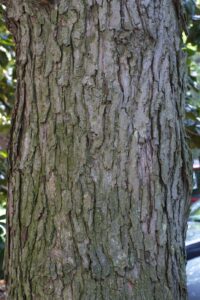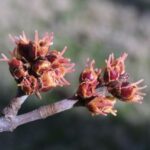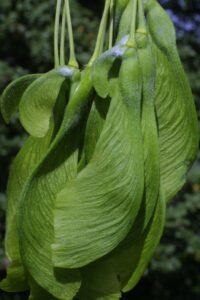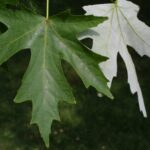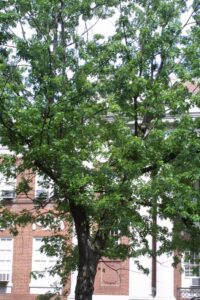Botanical Name:
Acer saccharinum
Family Name:
Sapindaceae
Description:
Silver maple is a tall, fast-growing, deciduous tree that can be quickly distinguished from our other native maples by its leaves that are deeply lobed with light green color on the upper surface and silvery undersides. It can be an elegant tree with a short, thick trunk and an open spreading crown. The bark of older trees is gray with long, shaggy strips or scaly ridges.
Size:
50-80’ tall; 30-50’ spread
Habitat and Range:
Silver maple is found across the eastern United States and adjacent Canada as far west as eastern Kansas and Nebraska. It likes wet soils and is often found in floodplains and river bottomlands. Due to conversion of bottomland forests to agriculture, it is not as abundant in its native habitat as it once was.
Attributes:
Silver maple was once widely planted in urban landscapes, but it is now less popular, because its branches are prone to breakage in high winds or in icy weather. Careful attention to pruning is needed to limit the chances of broken limbs. The relatively shallow root system can damage sidewalks and invade sewer pipes. Due to these drawbacks, silver maple is on South Bend’s list of prohibited trees to plant within the public right-of-way.
Wildlife Value:
Silver maples produce abundant winged fruits that are favored by a variety of birds, such as grosbeaks, finches, and turkeys. The fruits are also readily eaten by squirrels and chipmunks, and squirrels in particular use the fruits as a late winter or early spring food source. Cavities in the trunks and branches serve as nesting or sheltering sites for birds (owls, woodpeckers) and mammals (raccoons, opossums, squirrels). The flowers provide an early season pollen source for bees.
Did you know?
• Silver maple is the first of our maples to produce flowers in the springtime, sometimes breaking bud as early as February.
• Despite the promising sounding scientific name (Acer saccharinum), silver maple produces sap with a substantially lower sugar content than the sap from its more famous relative, the sugar maple (Acer saccharum).
Benefits to Our Community (based on carbon dioxide sequestered, storm water runoff avoided, and air pollution removed each year):
Over the next 15 years, this tree will give back $5,100 worth of benefits to our community.
